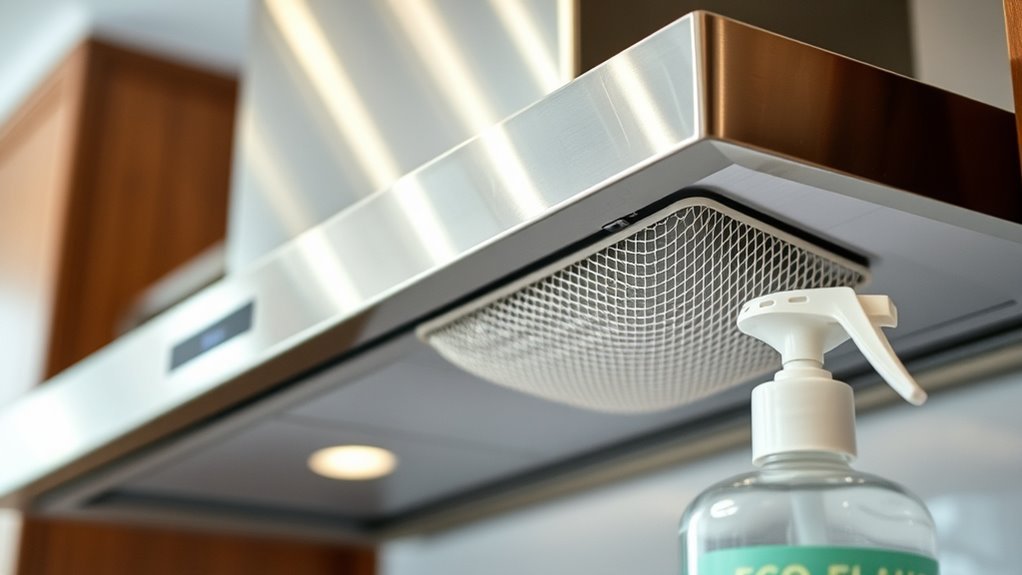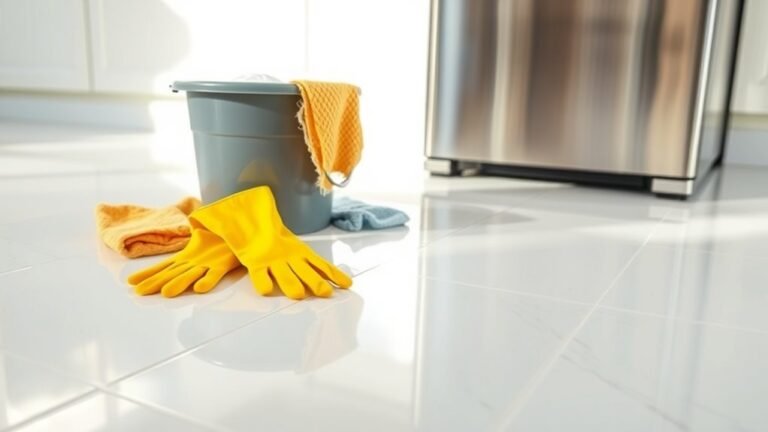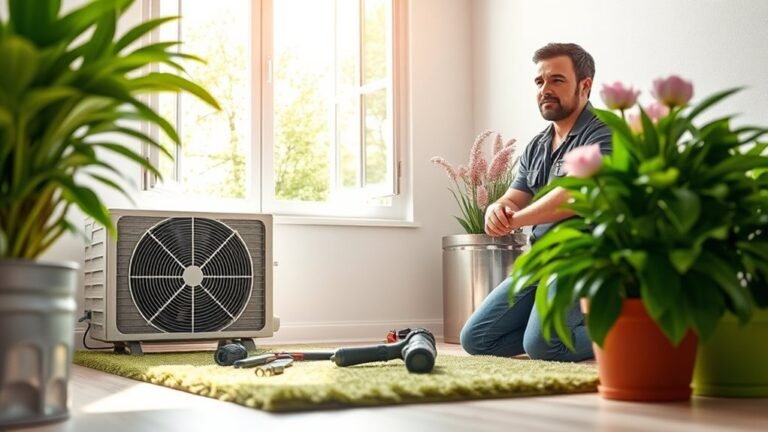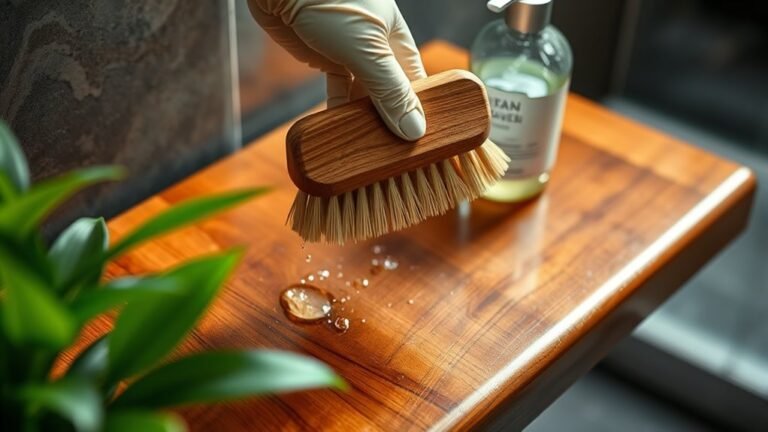Daily Maintenance Tips for Range Hood
To keep your range hood efficient, clean mesh or baffle filters regularly and replace charcoal ones as needed. Wipe down the exterior with gentle cleaners to avoid grease buildup. Check the ventilation duct for blockages to maintain airflow, and listen for unusual fan noises that might signal motor issues. Don’t forget to clean or replace light bulbs so you always have good visibility while cooking. If you want to keep your kitchen air fresh and your hood running smoothly, there’s more helpful info ahead.
Inspect and Clean the Filters

One of the most important steps in maintaining your range hood is inspecting and cleaning the filters regularly. You’ll want to identify the filter types your hood uses—typically mesh, baffle, or charcoal filters. Each requires a different cleaning approach, so knowing which you have is key to keeping your kitchen air fresh. For mesh and baffle filters, washing them every one to three months is usually enough, while charcoal filters often need replacing instead of cleaning. Sticking to the right maintenance frequency prevents buildup that can reduce your hood’s efficiency and keeps your cooking space freer from grease and odors. By staying on top of your filters, you guarantee your range hood works smoothly, giving you more freedom to enjoy your kitchen without hassle.
Wipe Down the Exterior Surfaces
After keeping your filters clean, the next step is to focus on the exterior surfaces of your range hood. You want to keep these surfaces spotless, as grease and dust can build up quickly. Choose cleaning solutions that are compatible with your range hood’s surface materials—stainless steel, glass, or painted finishes all need different care. Avoid harsh chemicals that could damage the finish or strip protective coatings. Instead, use gentle, non-abrasive cleaners or a simple mix of warm water and mild detergent. Wipe down the exterior with a soft cloth, moving in the direction of the grain if it’s stainless steel. Doing this daily not only maintains your hood’s look but also preserves its function, giving you the freedom to cook without worrying about grime or damage.
Check and Clear the Ventilation Duct

While your range hood does most of the heavy lifting in filtering air, the ventilation duct is where the airflow actually escapes. Keeping this duct clear guarantees ideal duct airflow and maximizes ventilation efficiency, giving you the freedom to cook without worrying about lingering odors or smoke. Here’s how you can check and clear it:
The ventilation duct is key to airflow escaping, ensuring efficient ventilation and odor-free cooking.
- Inspect the duct regularly for any blockages like grease buildup or debris.
- Use a flexible brush or vacuum to remove any obstructions gently.
- Verify the duct connection to the hood and exterior vent is secure and airtight.
Monitor the Fan and Motor Operation
Keeping an eye on your range hood’s fan and motor is essential to guarantee they’re working efficiently. You want to listen closely for any unusual fan noise, like rattling or grinding, which can signal a problem. If you notice louder or irregular sounds, it might mean debris is stuck or the motor’s struggling. Regularly check the motor efficiency by feeling if the airflow remains strong and consistent. A weak breeze could mean your motor isn’t running at full power or needs maintenance. Staying alert to these signs helps you act before bigger issues arise, saving you time and hassle. By monitoring fan noise and motor efficiency, you keep your kitchen fresh and your range hood running free without unexpected breakdowns.
Replace or Clean the Light Bulbs Regularly

If you want your cooking area to stay well-lit and safe, you should replace or clean the light bulbs in your range hood regularly. Proper lighting helps you see what you’re cooking and reduces accidents. To keep things efficient and bright, consider these tips:
- Choose the right light bulb types for your hood, like LED or halogen, focusing on energy efficiency to save power and money.
- Clean bulbs gently with a soft cloth to remove grease and dust, which can dim the light and reduce lifespan.
- Replace bulbs promptly when they flicker or burn out to maintain consistent illumination.
Frequently Asked Questions
How Often Should I Schedule Professional Servicing for My Range Hood?
Think of your range hood like a trusty steed that needs regular care to keep running free. You should schedule professional servicing about once a year to guarantee everything’s in top shape. While you handle daily cleaning frequency, this maintenance schedule helps prevent grease buildup and keeps your hood’s performance wild and efficient. Sticking to this routine means you can enjoy your kitchen without being chained down by unexpected repairs.
Can I Use Any Type of Cleaner on the Range Hood Filters?
You shouldn’t use just any cleaner on your range hood filters. When it comes to filter cleaning, it’s best to avoid harsh chemicals that can damage the metal mesh or charcoal. Mild dish soap or a degreaser specifically made for kitchen appliances works great. Sticking to the right cleaner types lets you keep your filters effective without risking damage, giving you the freedom to enjoy a fresh, well-functioning kitchen without hassle.
What Type of Grease Should I Use to Lubricate the Fan Motor?
When it comes to fan maintenance, you’ll want to use the right grease types to keep your range hood motor running smoothly. Generally, a high-quality, lightweight machine oil or a silicone-based grease works best for lubricating fan motors. Avoid heavy greases that can attract dust or gunk up the motor. Using the right grease means you won’t be tied down by frequent repairs, giving you the freedom to enjoy your kitchen hassle-free.
Are There Any Specific Safety Precautions When Cleaning the Range Hood?
When cleaning your range hood, you’ll want to use proper safety gear like gloves and goggles to protect your skin and eyes from harsh cleaners. Make sure the hood is turned off and unplugged before you start. Use gentle cleaning techniques, like a soft cloth and mild detergent, to avoid damaging surfaces. Taking these precautions lets you maintain your hood safely and freely, so you can enjoy a clean kitchen without worry.
How Do I Know if My Range Hood Needs to Be Replaced?
Imagine your range hood as an old knight—brave but aging. You’ll know it’s time for a replacement when its lifespan, usually around 10-15 years, starts showing signs: strange noises, poor ventilation, or grease buildup despite cleaning. If it’s not keeping your kitchen fresh or energy bills are climbing, it’s your cue to regain freedom from frustration by upgrading to a more efficient, modern model. Don’t let outdated tech hold you back!






